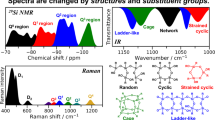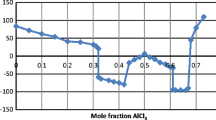Abstract
A novel quantitative structure-property relationship (QSPR) model for estimating the solution surface tension of 92 organic compounds at 20 °C was developed based on newly introduced atom-type topological indices. The data set contained non-polar and polar liquids, and saturated and unsaturated compounds. The regression analysis shows that excellent result is obtained with multiple linear regression. The predictive power of the proposed model was discussed using the leave-one-out (LOO) cross-validated (CV) method. The correlation coefficient (R) and the leave-one-out cross-validation correlation coefficient (R CV) of multiple linear regression model are 0.991 4 and 0.991 3, respectively. The new model gives the average absolute relative deviation of 1.81% for 92 substances. The result demonstrates that novel topological indices based on the equilibrium electro-negativity of atom and the relative bond length are useful model parameters for QSPR analysis of compounds.
Similar content being viewed by others
References
BORTOLOTTI M, BRUGNARA M, DELLA VOLPE C, MANIGLIO D, SIBONI S. Molecular connectivity methods for the characterization of surface energetics of liquids and polymers [J]. J Colloid Interface Sci, 2006, 296(1): 292–308.
YANG Chun-sheng, ZHONG Chong-li. A new model for prediction of surface tension of pure fluids [J]. Chinese J Chem Eng, 2004, 12: 85–91.
ENDERS S, KAHL H, WINKELMANN J. Surface tension of the ternary system water plus acetone plus toluene [J]. J Chem Eng Data, 2007, 52(3): 1072–1079.
WANG Jie, DU Hong-ying, LIU Huan-xiang, YAO Xiao-jun, HU Zhi-de, FAN Bo-tao. Prediction of surface tension for common compounds based on novel methods using heuristic method and support vector machine [J]. Talanta, 2007, 73: 147–156.
REN Yue-ying, LIU Huan-xiang, YAO Xiao-jun, LIU Man-cang, HU Zhi-de, FAN Bo-tao. The accurate QSPR models for the prediction of nonionic surfactant cloud point [J]. J Colloid Interface Sci, 2006, 302: 669–672.
DAI Yi-min, HUANG Ke-long, LI Xun, CAO Zhong, ZHU Zhi-ping, YANG Dao-wu. Simulation of 13C NMR chemical shifts of carbinol carbon atoms by using quantitative structure-spectrum relationships [J]. Journal of Central South University of Technology, 2011, 18(2): 323–340.
REID C R, SHERWOOD T K. The properties of gases and liquids [M]. New York: McGraw-Hill, 1966: 398–400.
EGEMEN E, NIRMALAKHANDAN N, TREVIZO C. Prediction of surface tension of organic liquids using artificial neural networks [J]. Environ Sci Technol, 2000, 34: 2596–2600.
STANTON D T, JURS P C. Computer-assisted study of the relationship between molecular structure and surface tension of organic compounds [J]. J Chem Inf Comput Sci, 1992, 32: 109–115.
KAUFFMAN G W, JURS P C. Prediction of surface tension, viscosity, and thermal conductivity for common organic solvents using quantitative structure-property relationships [J]. J Chem Inf Comput Sci, 2001, 41: 408–418.
GAO Shuo, CAO Chen-zhong. Extending bond orbital-connection matrix method to the QSPR study of alkylbenzenes: Some thermochemical properties [J]. J Mol Struct: Theochem, 2006, 778: 5–13.
WIENER H. Structural determination of paraffin boiling points [J]. J Am Chem Soc, 1947, 69: 17–20.
MOHAJERI A, HEMMATEENEJAD B, MEHDIPOUR A, MIRI R. Modeling calcium channel antagonistic activity of dihydropyridine derivatives using QTMS indices analyzed by GA-PLS and PC-GA-PLS [J]. J Mol Graph Model, 2008, 26: 1057–1065.
DAI Yi-min, WEN Song-nian, NIE Chang-ming, LI Zhong-hai. A novel quantum topological index and predicting physical-chemical properties of the lanthanide [J]. Chin J Inorg Chem, 2005, 21(8): 1015–1019.
DAI Yi-min, LI Xun, CAO Zhong, YANG Dao-wu, HUANG Ke-long. Modeling flash point scale of hydrocarbon by novel topological electro-negativity indices [J]. CIESC Journal, 2009, 60(10): 2420–2425.
DAI Yi-min, LI Xun, LIANG Bo, CAO Zhong, YANG Dao-wu, HUANG Ke-long. Quantitative relationship between 13C nuclear magnetic resonance chemical shift and structural parameters of acyclic alcohol [J]. Chin J Anal Chem, 2009, 37(12): 1754–1758.
WEAST R. CRC handbook of chemistry and physics [M]. 70th ed, Boca Raton, FL: CRC Press, 1989–1990.
ZHOU Cong-yi, CHU Xi, NIE Chang-ming. Predicting thermodynamic properties with a novel semi-empirical topological descriptor and path numbers [J]. J Phys Chem B, 2007, 111: 10174–10179.
JAPER J J. The surface tension of pure liquid compounds [J]. J Phys Chem Ref Data, 1972, 1: 841–1010.
KATRITZKY A R, SLAVOV S H, DOBCHEV D A, KARELSON M. Rapid QSPR model development technique for prediction of vapor pressure of organic compounds [J]. Comput Chem Eng, 2007, 31: 1123–1130.
ESCOBEDO J, MANSOORI G A. Surface tension prediction for pure fluids [J]. AIChE J, 1996, 42: 1425–1433.
GOLBRAIKH A, TROPSHA A. Beware of q2 [J]. J Mol Graph Model, 2002, 20: 269–276.
AGRAWAL V K, BANO S, KHADIKAR P V. QSAR study on 5-Lipoxygenase inhibitors using distance-based topological indices [J]. Bioorg Med Chem, 2003, 11: 5519–5527.
CHATERJEE S, HADI A S, PRICE B. Regression analysis by examples [M]. 3rd ed, Wiley: New York, 2000: 21–50.
Author information
Authors and Affiliations
Corresponding author
Additional information
Foundation item: Projects(20775010, 21075011) supported by the National Natural Science Foundation of China; Project(2008AA05Z405) supported by the National High Technology Research and Development Program of China; Project(09JJ3016) supported by Hunan Provincial Natural Science Foundation, China; Project(09C066) supported by Scientific Research Fund of Hunan Provincial Education Department, China; Project(2010CL01) supported by the Foundation of Hunan Provincial Key Laboratory of Materials Protection for Electric Power and Transportation, China
Rights and permissions
About this article
Cite this article
Dai, Ym., Liu, Yn., Li, X. et al. Estimation of surface tension of organic compounds using quantitative structure-property relationship. J. Cent. South Univ. Technol. 19, 93–100 (2012). https://doi.org/10.1007/s11771-012-0977-6
Received:
Accepted:
Published:
Issue Date:
DOI: https://doi.org/10.1007/s11771-012-0977-6




